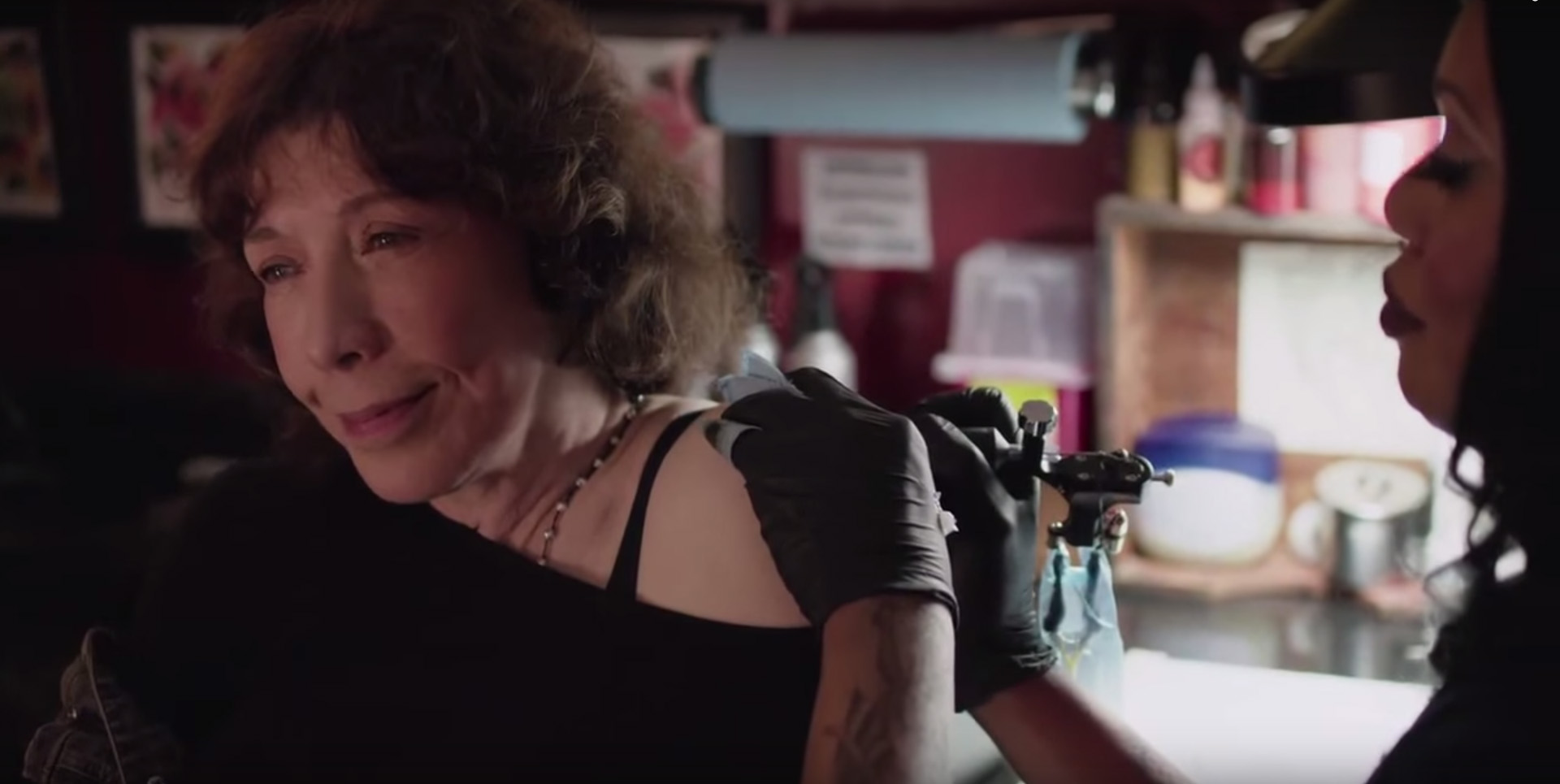Lily Tomlin was the first woman on television who ever made me laugh. She appeared on Laugh-In as Ernestine, the telephone operator with the ’40s hairstyle and quick temper who snorted at her own jokes, back when the US had telephone operators–and only one phone company. Tomlin was also Edith Ann, a little girl about my age in an oversized rocking chair who ended every monologue by lisping, “And that’s the truth,” and blowing a raspberry.
I didn’t see Nashville when it first came out though my parents did, and afterward my father played its soundtrack incessantly. When I saw the film as an adult I didn’t really care for most of it–except the scenes with Tomlin’s not-at-all-comic (but Oscar-nominated) role, the married, gospel singer, a mother of two, young, deaf children, who has an affair with the young up-and-coming singer/songwriter (Keith Carradine). He has sex with many women but only has eyes for her. When he invites her to a club to watch him perform, she shows up but has obviously never been to a nightclub before. She is struck motionless when Carradine’s character sings a love song he’s penned (many of the actors in the film wrote their own songs, including Carradine, who won a “Best Original Song” Oscar for this one) looking straight at her. The camera doesn’t look away from her either.
Paul Weitz, who is about my age and is probably still best known as the director of American Pie, grew up with Tomlin too, which may be why he centered his latest film, Grandma (for which he also wrote the script) around her. 76-year-old women are not often the leads in mainstream American movies, especially not current ones, so I suppose I should be grateful, but I kept wishing this vehicle (and I don’t mean the antique car Tomlin’s character drives in the film) were a better one.
One of Weitz’s best ideas is to make Tomlin’s character queer, since none of us knew as children in the ’70s that the woman who wrote much of Tomlin’s most famous work, Jane Wagner, was also her romantic partner. The two legally married a couple of years ago, the final unambiguous, public “coming out” of many in that generation (and those who are a little older). Although Tomlin has maintained in interviews that she was always open about her sexuality and the media simply didn’t report it, the history some of us remember is a little more complicated. In the ’90s writer Armistead Maupin (Tales of the City) objected to Tomlin narrating The Celluloid Closet (which he wrote) a ’90s history of queers in film because he felt having a semi-closeted narrator was antithetical to the film’s message.
In the film Elle Reid (Tomlin) is a lesbian poet whose heyday was in the ’70s: she’s now an underemployed academic whose talent and reputation is enough to attract a much younger girlfriend, Olivia (Judy Greer). Greer has a warm presence and hilariously wears the anti-fashion sometimes donned by queer women of a certain age (batik pants!), but we see no chemistry between these two characters who are supposed to be hot and heavy lovers, so their breakup in the first scene is a blessing. When Elle’s only granddaughter Sage (Julia Garner) comes to her and confesses, “I’m pregnant,” Elle is too broke to give Sage the money she needs for an abortion. So the two set off in Elle’s old car (which actually belonged to her late partner, Vi) to try to track down the money for the procedure. Another nice touch is that this film doesn’t make a big deal about abortion; Sage is a high school student who seems to have self-esteem issues and her boyfriend (Nat Wolff) isn’t exactly great father material (Elle asks him, “Why didn’t you use a condom, or for humanity’s sake get a vasectomy”), so this choice makes the most sense for Sage, the way it does for many women and girls in real life. I’ve loved Garner in other films, but here she doesn’t demonstrate much of a flair for comedy, especially in reaction shots–or maybe she doesn’t seem skilled in comparison to a master like Tomlin.
The problem is the script isn’t very funny and when it’s serious, it’s not very acutely observed. Everything this film knows about women’s studies and lesbian poets could have been cribbed from a Wikipedia page (though Weitz knows some queer women writers, and is familiar enough with the work of Eileen Myles to quote it at the very beginning of the film). Some straight men can make very good films about queer women–Show Me Love and Blue Is the Warmest Color (with some reservations) are two of my favorites. But Grandma doesn’t really go much under the surface; Elle misses Vi (who was Black–directors, when we ask for more characters of color onscreen, we don’t mean dead ones whom we see only in still photos and drawings), and had good sex with Olivia and that’s… about it. When we see Elle trying to raise money by selling her first editions of famous feminist books, one by a notorious homophobe, Betty Friedan, and another by transphobe Germaine Greer–even though we find out Elle’s friendly enough with one trans woman (Laverne Cox, majestic as always) to have lent her money–Elle doesn’t let on that she might have any objections to these authors or that she knows anyone who does (and with plenty of transphobes among some self-described feminists, especially older ones, today, this detail would be a relevant one).
Although we see artifacts of ’70s Southern California (a dream catcher and wind chimes in Elle’s home), we don’t get a sense of Elle as a person who lived in that time and subculture the way a film that was actually shot in the ’70s, the underrated, under-seen detective story The Late Show, gives us; Tomlin’s character in that film wrote affirmations on her mirror. An interesting film could be made about a character like Elle’s transition from ’60s free spirit to 2010s misanthrope (which Sage confuses with “philanthropy”), perhaps with a script by Wagner (if she’s not retired) since she did such a good job writing the transformation of feminist women and not-so-feminist men from the ’70s to the ’80s in Tomlin’s ’80s hit, one-woman, stage show The Search for Signs of Intelligent Life in the Universe.
As in Tangerine the straight writer-director tips his hand by making a straight white-guy supporting role the most complex and best thought-out character in the film–Sam Elliott’s, Karl, an old flame of Elle’s (who explains this relationship to Sage as, “I knew I liked women. I just didn’t like myself”)–completely avoids cliché, the only character to do so. Elle’s daughter and Sage’s mom is a cold workaholic, the type of woman we’ve see in movies before, over and over. Elle is the dirty-talking, no-filter, “surprisingly” antagonistic stereotype many older women are called on to play these days, which stretches back to Dorothy on The Golden Girls and beyond: nearly 50 years ago, when Tomlin’s Laugh-in co-star Ruth Buzzi played her most famous character, an older woman who hits men with her handbag, it was already a tired trope. When people talk about how in this supposed “golden age” of TV that premium television is “just like” film, Grandma is the type of predictable, middle-of-the-road, haphazardly written movie that they mean. My advice is to watch other films and see if they change your mind.
[youtube_sc url=”https://www.youtube.com/watch?v=XspFo3jiVR8″ iv_load_policy=”3″]
___________________________________________________
Ren Jender is a queer writer-performer/producer putting a film together. Her writing. besides appearing every week on Bitch Flicks, has also been published in The Toast, RH Reality Check, xoJane and the Feminist Wire. You can follow her on Twitter @renjender












